2. Ocean Data Assimilation System
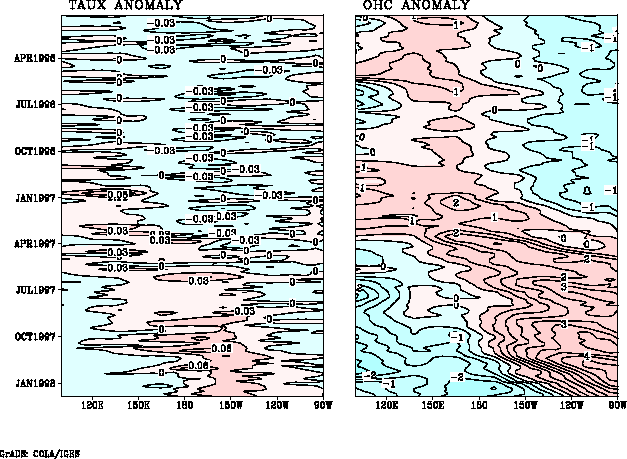
| Fig. 1. Longitude-time cross section of the anomalies of the zonal wind stress (left; N/m2) and the ocean heat content (left; averaged temperature between the surface and 260m, °C) along the equator obtained from ODAS |
The warm Kelvin wave induced around 150°E in January 1997 is visible in the chart. This was generated by the strong westerly anomaly observed in the lower troposphere at the end of 1996. This warm wave propagated eastward and reached the eastern coast in April. The second warm wave was formed in the west in March and followed the first one to the eastern Pacific. This caused further rise in the OHC in the eastern equatorial Pacific, and led to the warming of the sea surface temperatures there (Fig. 2).
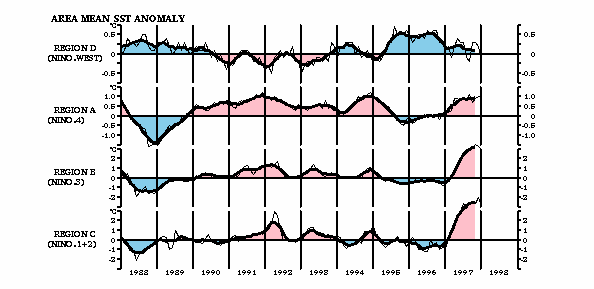
| Fig. 2. The time series of the area mean sea surface temperature anomaly (°C) over (from the top) Region D (130°E - 150°E, 14°N - Equator), Region A (160°E - 150°W, 4°N -4°S), Region B (150°W - 90°W, 4°N -4°S, almost equivalent to NINO3), and Region C (90°W - 80°W, Equator - 10°S). |
Figure 3 indicates the longitude-depth cross sections of the temperatures along the equator in February, May, August, and November 1997, and February 1998. In February 1997, the warm anomaly is still centered in the western half of the Pacific. In May, when the onset of the El Niño event is evident in SST, the warm anomalies are spread almost in the entire equatorial Pacific along the thermocline. In August, negative anomaly was clearly found in the west. In November, when the SST anomaly in NINO3 was at the peak, the negative anomaly in the west and positive anomaly in the east were intensified and east west contrast was very clear. The cold anomaly in the west further strengthened and expanded eastward in February 1998. Thus the subsurface temperature features of different phases of the event are identified, and thier usefulness in the monitoring of ENSO is evident.

| Fig. 3. Longitude-depth cross sections of temperatures anomalies (°C) along the equator. |
3. ENSO Prediction
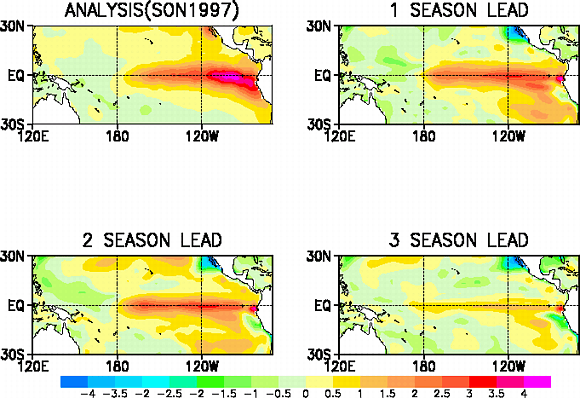
| Fig. 4. Observed (left top) and predicted mean sea surface temperature anomalies for September, October and November 1997. The predictions started from July (right top), April (left bottom), and January (right bottom) of 1997. |
The statistical performance of the model was investigated with 40 runs of one year forecasts initialized from 1986 to 1996. The initial times are spread equally in each season. Figure 5 shows the anomaly correlations and root mean square errors for NINO3 and NINO3.4 (170°W - 120°W, 5°N -5°S). The figure shows that the skill of the model was deteriorated substantially after 1992 (Note that this experiment does not include the event of 1997/98). Similar reduction of the skill in 1990's with NCEP CMP10 was reported by Ji et al (1996). They pointed out that the skill of the persistency was also reduced and that their EOF analysis indicated less contribution of the ENSO mode to the total SST variations in 1990's, and they suggested that this skill reduction should be attributed to natural changes. Our independent experiment showing the similar skill shift supports their suggestion.
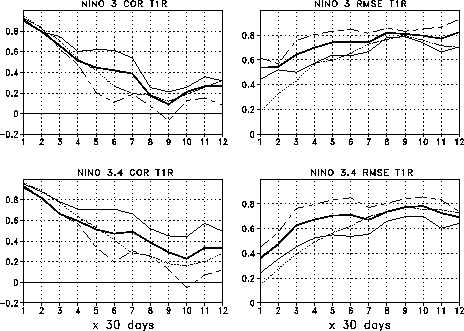
| Fig. 5. Anomaly correlation (left) and root mean square error (right, °C) of the mean sea surface temperature over NINO3 (top) and NINO3.4(bottom) for the 40 runs of one-year forecasts with JMA couple model. Thick lines are for all the 40 runs. Solid and dashed thin lines are for the cases from 1986 to 1991 and from 1992 to 1996, repectively. The dotted lines are for the persistence. The abscissa indicates the forecast time in the unit of 30 days, and the value for the mean of the first 30 days of integration and is plotted at 1 in this axis. |
In order to investigate the systematic model errors which depend on seasons of prediction period and initial condition, the biases are plotted in the four panels in Fig. 6; for instance, in the upper-left panel, predictions start in the boreal winter (December, January, and February). Predictions starting in boreal winter and spring show large positive biases in July through November. On the other hand, predicted SSTs tend to be cold from December to April when the predictions start in boreal summer and fall.
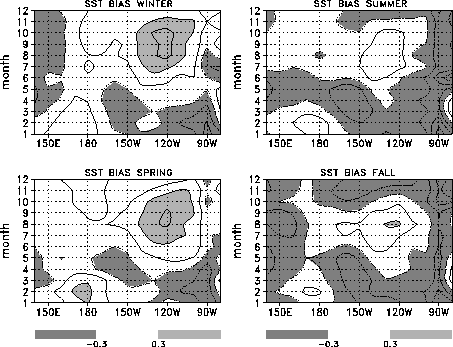
| Fig. 6. Season-dependent biases along the equatorial band, 5°S - 5°N. Biases depending on seasons of initial conditions are shown in four panels; boreal winter (December-January-February, upper left), spring (lower left) summer (upper right), and fall (lower right). The contour interval is 0.3°C, and areas where the bias is greater (less) than +0.3°C (-0.3°C) are shaded. The ordinate means calendar months. |
These biases may be partly attributed to the inadequacy of the simple flux adjustment applied to the model. They may also be contributed by the deficiency of the ocean model to produce the realistic seasonal variation. When this bias is subtracted, the performance of the model is slightly better, though it should be noted that this is not independent verification.
4. Summary
Reference
Ji, M., A. Leetmaa, and V. E. Kousky, 1996: Coupled model predictions of ENSO during the 1980s and 1990s at the National Centers for Environmental Prediction. J. Climate, 9, 3105-3120.
Kimoto, M., I. Yoshikawa, and M. Ishii, 1997: An ocean data assimilation system for climate monitoring. J. Meteor. Soc. Japan, 75, 1-16.
Levitus, S., 1982: Climatological Atlas of the World Ocean. NOAA Prof. Paper No. 13, U.S. Govt. Printing Office, 173pp., 17 fiche.
Louis, J., M. Tiedtke and J. F. Geleyn, 1982: A short history of PBL parameterization at ECMWF, Workshop on Planetary Boundary Layer Parameterization 25-27 Nov. 1981, 59-80.
Mellor, G. L. and T. Yamada, 1974: A hierarchy of turbulence closure models for planetary boundary layers. J. Atmos. Sci., 31, 1791-1806.
Mellor, G. L. and T. Yamada, 1982: Development of a turbulence closure model for geophysical fluid problems. Rev. Geophys. Space Phys., 20, 851-875.
Corresponding author:
Dr. Naoyuki Hasegawa
El Niño Monitoring and Prediction Center
Climate Prediction Division
Japan Meteorological Agency
1-3-4, Otemachi, Chiyoda-ku, Tokyo 100-8122, Japan
Email: naohase@naps.kishou.go.jp